Disclosure: Meeple Mountain received a free copy of this product in exchange for an honest, unbiased review. This review is not intended to be an endorsement.
Cracked Earth: Pangea in Pieces is a tile-laying worker management game for 1-5 players. Players score points by dominating the ever-changing continents of Pangea with their DinoMeeples. It’s a game that grows and shifts with every move. Think a prehistoric Carcassonneville with earthquakes and you’re part way there.
Hi, I’m Avatar Tom and will be popping in with some additional information about the game. For instance, between the time my review copy arrived and the writing of this review, the game has gone through some artistic changes. The tiles in my photos will reflect the older artwork. I have updated the dinosaur names used to match the last information I was given by Gold Seal Games prior to this article being published.
Prepping the Game
Each player chooses a color and takes all ten DinoMeeples of that color. They then place a matching color score marker to the side of the scoring track.
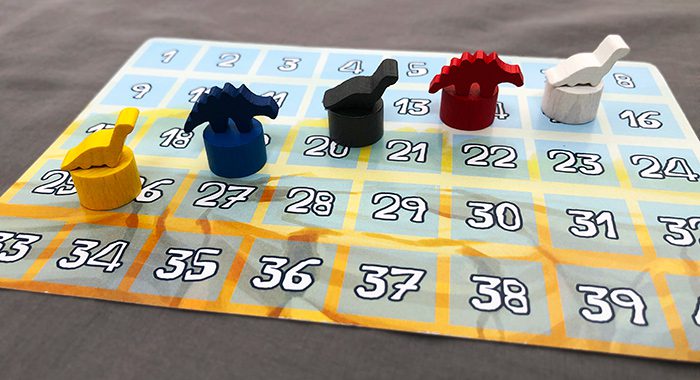
The tiles for Cracked Earth come in seven different types, each marked with a letter (A-G) and (for B-G) a corresponding, historically accurate Prehistoric Period name.
Sort these tiles into piles according to letter/Period. Then, depending on the number of players, remove a specific number of tiles corresponding to the number of players. (For 2 players remove 4 tiles from each Period; for 3 players remove 3 tiles from each Period, etc.). Before placing the removed tiles back in the box, check to make sure you haven’t removed any Asteroid tiles. If so, randomly choose another tile from that Period to remove and add the Asteroid back in.

Randomly mix all of the tiles of a given Period and set the piles in alphabetical order to the side of the playing area.
Give each player a letter “A” tile. This is your starting tile.
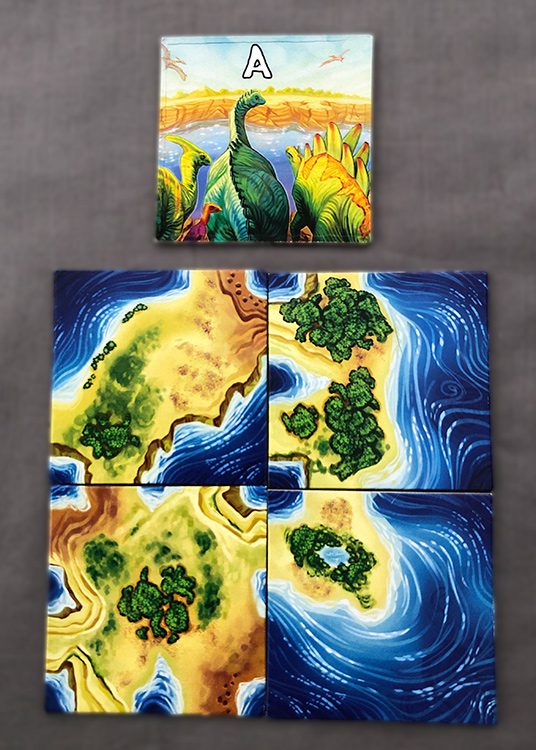
The oldest player (“the dinosaur in the room”) goes first. That player sets their “A” tile on the playing area and places two DinoMeeples on the land part of that tile. The player then draws a new tile from the “B” stack (Early Triassic Period) to be played on their next turn. That tile is kept hidden from the other players.
Each additional player then places their “A” tile such that one land edge of their tile is adjacent to the land edge of another tile already on the board. They then add two of their DinoMeeples to the land part of their tile, then select a tile from the “B” stack for their next turn.

Playing the Game
On a turn, players can take any or all of the following four actions in any order they choose:
Place a Tile
Growing Pangea, or placing a tile, is the only required action a player must take on a given turn.
After placing all of the starting “A” tiles to form an initial central landmass, the land-edge-to-land-edge rule is dropped. While all tiles played for the rest of the game must start connected to a tile already on the board, they may be placed in such a way that any tile feature (land or water) can be adjacent to any other feature type.
Having Babies
If you have two DinoMeeples on the same land section of a tile, they can have a baby. Only one pair of your DinoMeeples can do this per turn, regardless of how many pairs you may have, so choose which pair to add to wisely.
Okay, so the game just calls them “dinosaurs.” DinoMeeples is just more fun to say.
On a turn, players can take up to 4 movement actions. This can be divided amongst your DinoMeeples or be devoted entirely to a single DinoMeeple. DinoMeeples may only be moved orthogonally (up/down, right/left) from tile to tile.
The different features on a tile determine the number of movement actions it takes to cross it.
For instance, if two land tiles are adjacent to one another, it only takes one movement action to move from one to the other.
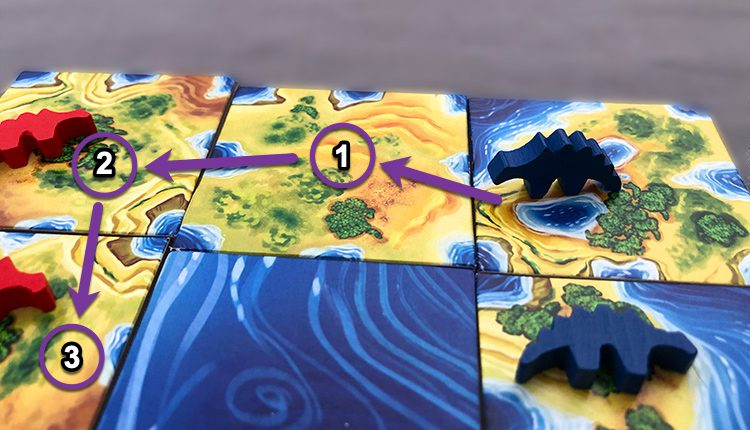
DinoMeeples can also swim across the ocean to other land tiles. To do so, their first move action must be to enter the water on their current land tile. Before climbing onto land, they need to exit from the water on the new land tile with another move action.
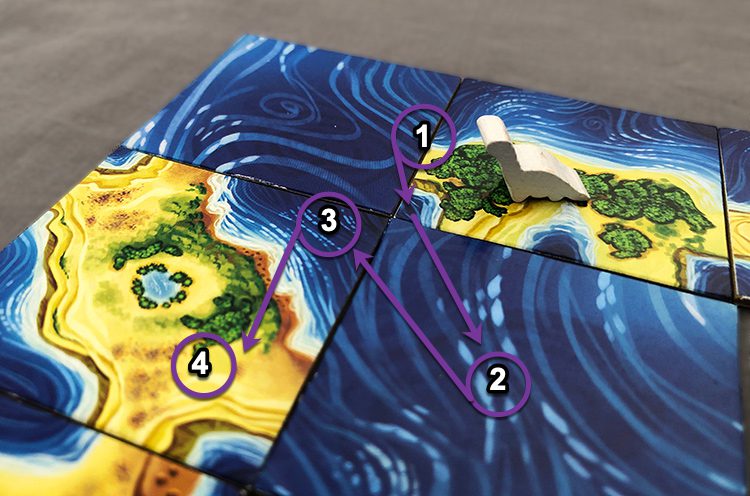
DinoMeeples can not only swim across the water, they can also end their turns in the water.
I’ll get more into scoring in a moment, but for now know that scoring is based on who has the most dinosaurs on all of the various continents (landmasses). Moving your DinoMeeples will be essential to your score.
Shift a Tile
Keep in mind, this is a very early, very cracked Earth we’re building and inhabiting. Pangea is still forming and reforming, with continents breaking apart — some going adrift, while some joining up with other landmasses.
As part of your turn, you can shift any single tile you have at least one DinoMeeple on. That tile must be moved orthogonally in such a way that it is still connected to other tiles. Tiles cannot be moved diagonally, nor can a lone tile be separated from the main water and land area.
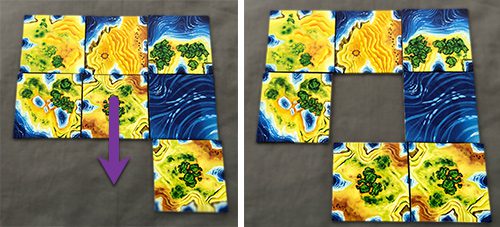
However, by moving tiles to the edge of the playing area, it is possible to create a second continent.

The option to shift tiles is one of the most intriguing, strategic parts of the game.
Scoring
Hidden somewhere in the “C” (Late Triassic), “E” (Late Jurrasic), and “G” (Late Cretaceous) Period tile stacks are Asteroids. When someone draws the Asteroid tiles from the “C” and “E” stacks, the game instantly pauses for scoring. In the “G” stack, drawing the Asteroid triggers the immediate end to the game.

As the scoring table indicates, there are several different strategies that can be effectively used to score points. A single tile continent scores the majority DinoMeeple holder 2 points. A two-tiled continent only scores one extra point and anything over seven land tiles only scores the majority owner 5 points.
Starting with the two tile or more continents, points are awarded to the player who has the second largest number of DinoMeeples present. As well, there are up to 3 bonus points available to the player who has the most DinoMeeples on the largest continent.
Ties are always rounded down.
As you may guess, Cracked Earth is a relatively low scoring game. With only three scoring opportunities throughout the game and 5 points being the most a single continent can give you (along with an extra 3 points if it is also the largest continent), you need to constantly reassess your scoring options. Knowing when and where to move your DinoMeeples is essential.
After the scoring in the “C” and “E” Periods, the player who drew the Asteroid tile then draws a new tile to be placed on their next turn.
The Game Changers
Throughout the game you will encounter tiles with one of five different dinosaurs on them, each with a special disruption to the game. They begin to appear slowly in the “B” (Early Triassic) and “C” (Late Triassic) tiles. By the “F” (Early Cretaceous) and “G” (Late Cretaceous) tiles the dinosaurs are more prevalent — and their powers become more aggressive.
In the earlier Periods the Velociraptors and Dilophosauruses will appear. Velociraptors stop all DinoMeeples on their continent from breeding; Dilophosauruses allow you to remove any single DinoMeeple on the continent the tile is connected to, either when initially placed or after being shifted as part of that player’s turn.
In the last two Periods of tiles, the Spinosaurus will allow you to remove any two DinoMeeples from the continent it is attached to, either when placed or after being shifted.
These DinoMeeples are then returned to the player of that color. While not necessarily in keeping with what dinosaurs did to other species, it does keep the playing field relatively even.
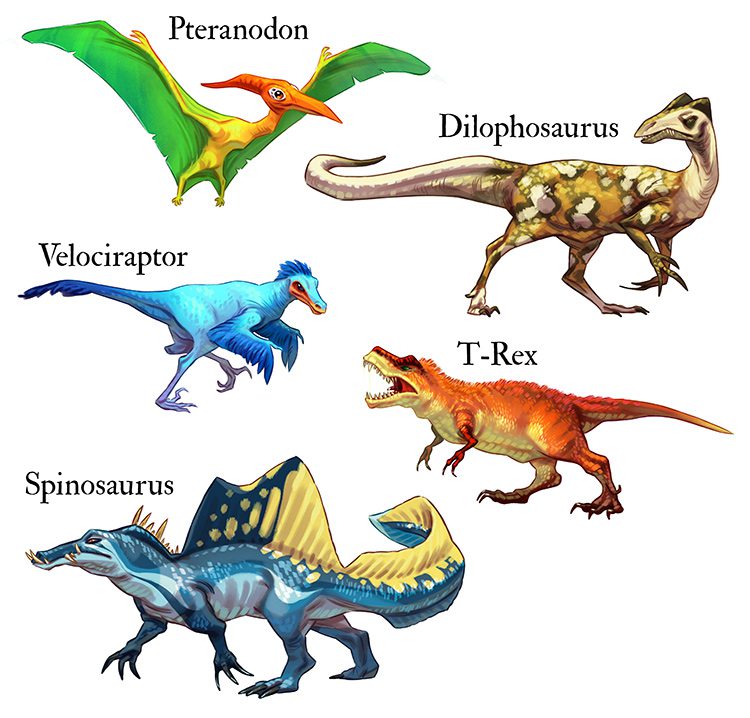
There are two other dinosaurs that will change the game. Pteranodons allow you to choose any two DinoMeeples (either yours or two from your opponents) from any continent and ‘fly’ them to the Pteranodon’s tile when it is initially placed; the T-Rex ties for first place on the continent it is connected to. (If two T-Rexes are attached to a continent, they both tie for first place. This means two T-Rexes would claim all points on a continent with less than seven tiles.)
Finally, Hatcheries (not shown) provide a 2 point-per-Hatchery bonus to the player with the most DinoMeeples on the continent they are a part of.
Cracked Impressions
My gaming group and I are all big fans of Carcassonne. Looking at Cracked Earth we initially saw the DinoMeeples as just another type of Meeple and equated scoring landmasses with scoring castles, with larger ones scoring more points. We hoped there was more to the game than that.
We quickly learned there was much more to the game.
Where Carcassonne is static, Cracked Earth is relatively fluid. This constant shifting of the tiles means you will need to continually adjust your strategy with the changes brought on by each players’ moves and is, in that way, reminiscent of Dokmus.
Consider, for a moment, that you’re playing a four-player game of Cracked Earth as Red. You place the first tile, along with two of your DinoMeeples. After your three opponents placed their first tiles and DinoMeeples, the board might look like this:

After all four players take their turn, the board could be added to and shifted to look like this:
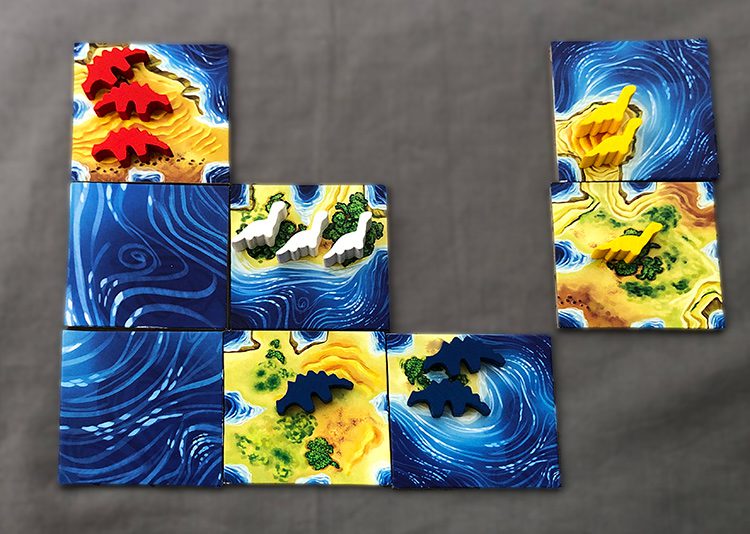
With each move, you’re reconsidering your options: do you want to add more DinoMeeples to that expanding landmass to try and score there or do you want to start a new landmass on an edge of the board? Do you use that Pteranodon to move two of your DinoMeeples to another landmass or do you use it to move two other DinoMeeples off of a landmass to give you greater numbers?
Keep in mind, you only have ten DinoMeeples to work with. After only five or six turns you’ll notice your DinoMeeples are running low. When you place your next tile, you’ll need to carefully plan out where you want it to go and how it will work in relation to your DinoMeeples and which tile you might want to shift.
The random timing of the scoring works to the game’s benefit. You know there will be 3 points during the game when scoring occurs, but you’re not exactly sure when that will happen. This creates a push-your-luck edge to the game that makes for some interesting decisions leading up to and during the laying of tiles in the “C” (Late Triassic), “E” (Late Jurassic), and “G” (Late Cretaceous) Periods.
As I write this in June of 2020, the US is still in partial Lockdown due to the COVID-19 pandemic. My weekly gaming group and I have been playing Cracked Earth over Zoom. I’ve suspended my webcam over a table and I do all of the placing and shifting tiles/DinoMeeples for everyone at their direction. I mention this to show there are plenty of physical board games you can play with friends online with a bit of creativity.
Okay, So Some Negatives
The pre-production copy I have does have some aspects that I hope will be improved in the final version. The two are somewhat interrelated.
Tiles & Water
All landmass tiles have water on them somewhere. If a DinoMeeple is ending its Movement phase in such a water section, the space really isn’t large enough for them to be clearly seen as being on that tile. (The project creator has told me the water sections will likely be enlarged in the final artwork, as might the overall tile size.)
DinoMeeples: Sizes and Shapes
I’m used to board games keeping costs down by using undersized cards that look tiny in my hands (I’m looking at you, Ticket to Ride). Making tiny DinoMeeples might make them fit on the tiles, but they can be frustratingly difficult to pick up and move around.
There are only two different types of DinoMeeple in the review copy. It would be great to have each color represented by a different type of dinosaur.
Final Thoughts
It’s fair to say that Cracked Earth: Pangea in Pieces surprised me with just how good it is. The mix of mechanics are well balanced and work nicely together. The game plays relatively quickly (10-15 minutes per player) and the changes throughout the game means you’re never given a chance to lose interest in what happens on other players’ turns. The end result is a game that is easy to learn but challenging to play well.
My gaming group is used to playing new games as a part of my reviews. They will always discuss things they like and don’t like about a game, but it’s rare that they ask to play one of these games again. Not only did we play it several times, but the game sparked a series of strategy discussions after each game. We are all intrigued by the game and look forward to playing it again, hopefully in person sometime in the not-too-distant future.
Cracked Earth: Pangea in Pieces is a game that would work equally well within a relaxed family setting or with a more serious group who can appreciate the (potentially cutthroat) strategy that comes with shifting tiles and eliminating your opponents’ pieces from the board.
Coming soon to a Kickstarter near you Cracked Earth: Pangea in Pieces challenges players with an ever-shifting land and oceanscape and struggles for continental population dominance. It is well worth your attention.



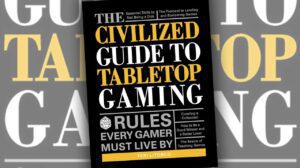

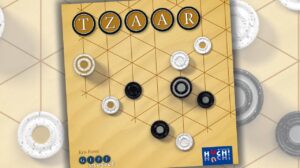





Add Comment